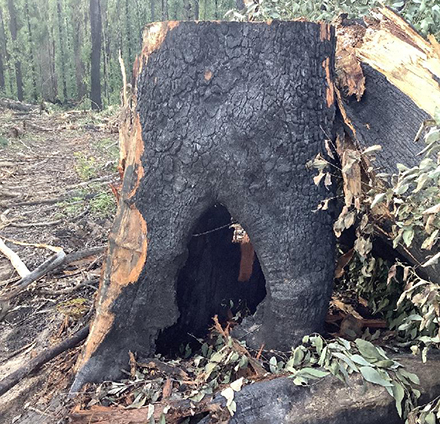Forestry Corporation regrets that it made an error during operations in Dampier State Forest 2019 and removed trees from an area that should have been protected around a disused mineshaft. Source: Timberbiz
Forestry Corporation carries out pre-harvest surveys and searches and marks all areas that need protection in electronic maps or in spray paint or tape on trees.
At the time of the incident, electronic mapping was newly introduced, and the mineshaft was not marked using the same method as the two nearby mine shaft exclusion zones.
Our contractor immediately reported the incident, and we reviewed our processes. The mine shaft was not damaged, but systems have been improved to prevent a similar incident occurring in future.
All staff and contractors now use a single electronic mapping system during operations, which provides complete and consistent information to operators, and we continue to monitor and improve our systems.
Forestry Corporation has also recently received a penalty in relation to a tree harvested during an operation under site specific operating conditions in South Brooman State Forest.
The PIN relates to one tree harvested during an operation under site specific operating conditions in South Brooman State Forest where all hollow bearing trees were required to be protected.
Forestry Corporation undertook ground assessments with trained staff walking through the forest to identify trees with visible hollows and identified and protected hundreds of such trees during the harvesting operations. One tree was determined by the EPA to have been a hollow bearing tree after it was felled, and Forestry Corporation has received this penalty notice. Forestry Corporation disputes it has felled a hollow bearing tree in breach of the rules and is considering whether it will contest the allegation in court.
Since the 2019-20 bushfires Forestry Corporation has adopted additional environmental safeguards above the requirements of the strict ruleset in place in NSW, the Coastal Integrated Forestry Operations Approval, to balance providing timber to local industry employing local people to produce important timber products and ensuring the forests can regenerate after the bushfires.
These safeguards including things like setting aside additional areas from harvesting in feed tree clumps and landscape exclusions and undertaking additional landscape surveys. These measures remain in place today.
We have also increased our focus on compliance with additional resources on the ground for planning and monitoring and are committed to complying with the stringent ruleset and minimising any environmental impact from operations so that the forests regenerate and provide both wildlife habitat and timber supply for future generations.






